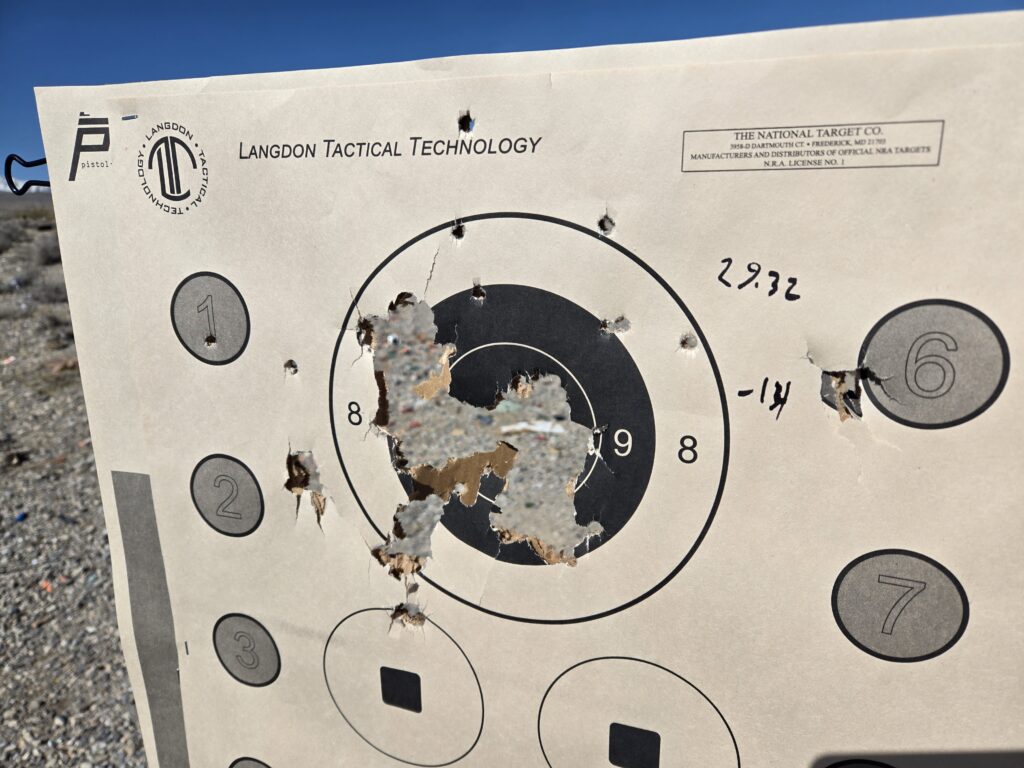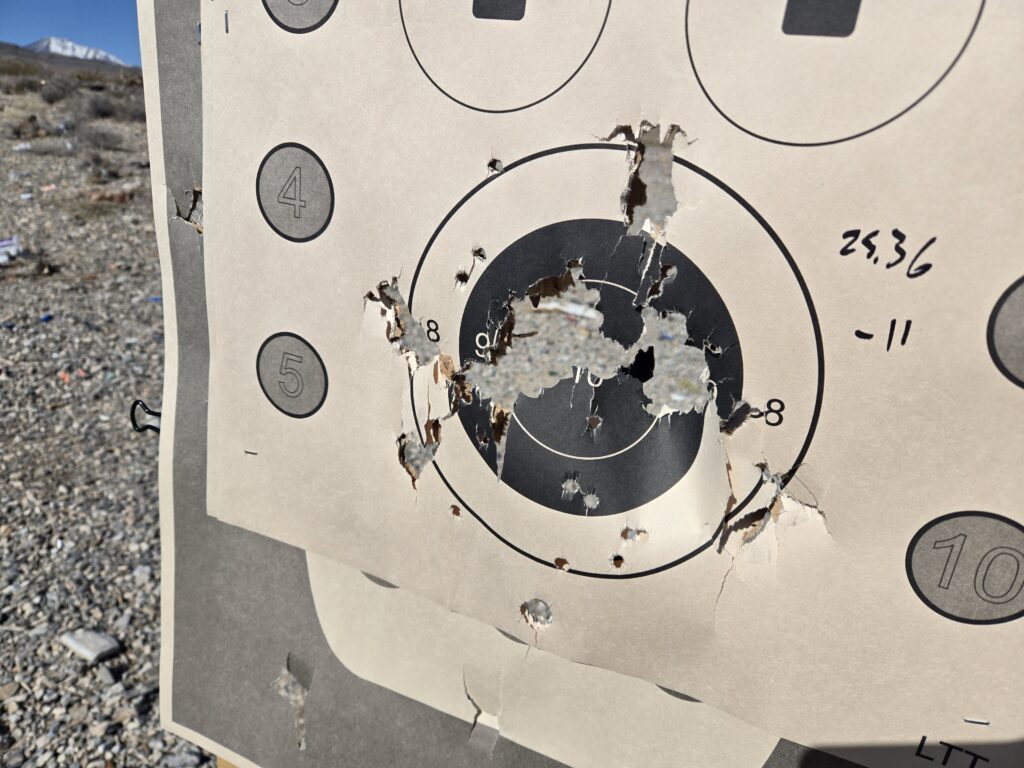
Recently I found myself browsing the internet, looking for additional drills to diversify my range time. One thing I’ve been focusing on this year is introducing movement, target transitions, and more rather than simply standing stationary against a single target. This led me to the Shotgun Assault Course from Nate Parker, which is based on the 10 Round Assault Course from Ethan Johns. This was a good start, but Nate’s drill requires a transition to your pistol. Wanting to remove this requirement, and introduce some more shotgun-specific manipulations, I started to brainstorm. This led me to what you see today, the Shotgun Battery Course.
Setting Up the Drill
The 10 Round Shotgun Battery Course is a really easy drill to set up. You need 8x rounds of buckshot, and 2x slugs. You’ll also want one B-8 target, and a shot timer. Place your target at 25 yards, then load your magazine with six rounds of buckshot. You will be reloading on the clock, so a way to carry spare shells will be necessary. Additionally, a way to separate your buckshot and slugs is important. Shooters may substitute slugs in place of buckshot for easier scoring.
Having distance markers such as cones will also be helpful here. You’ll want to mark 25 yards, 15 yards, and 7 yards to help you run this drill properly.
Scoring the 10 Round Shotgun Battery Course
Each round is worth 10 points, and with 10 rounds fired you have a total potential score of 100. A passing score is 80% on target. Any pellet outside of the 8-ring of the B-8 is a reduction of one point. Slugs outside of the circle is a reduction of 10 points. If a B-8 isn’t available, any target with an 8-inch scoring ring will suffice, such as an IDPA torso or Q-PT silhouette. Shooters using cheaper buckshot will likely see their scores suffer, providing a realistic standard for patterning of a defensive gun.

One of the major changes in the Shotgun Battery Drill compared to its inspirations is in the timing. Gone is the hard par time seen in the traditional Assault Course and its shotgun variant. Instead we use a tier system to provide various benchmarks, similar to my Shotgun Diamond Drill. While you cannot fail based upon a poor time, you can fall into lower scoring brackets. Here’s the breakdown of the par times:
- 20 Seconds or less: Expert
- 20-25 Seconds: Advanced
- 25-30 Seconds: Intermediate
- 30 Seconds or more: Novice
Firing the Drill
The 10 Round Shotgun Battery Course is fired as one continuous string. Once the timer starts, you’re going until you fire your tenth round on target, moving steadily from 25 yards past 7 yards. Be aware of your muzzle and trigger during this drill. Consider how you will manipulate the safety between distances as well.
Shooters start with the gun in their hand, safety on. You’ll want a round of buckshot in the chamber, with five additional rounds in the magazine. If using a gun with a magazine capacity under six rounds, load to full. Low or high ready are acceptable start positions for this drill, with the muzzle off target.
- 25 Yards
- On the beep, perform a double slug changeover, ejecting 2x rounds of buckshot and replacing them with slugs. Fire both slugs while standing unsupported at the target, then advance towards the next line. Replenish your rounds fired with buckshot as you advance.
- 15 Yards
- Fire 2x rounds standing, then advance to 7 yards. Replenish your rounds fired as you move forward.
- 7 Yards
- Fire 3x rounds standing, then fire 3x more rounds while advancing towards the target. If necessary, perform an emergency reload to get all 10 rounds onto target.
There will be some variation on how shooters perform the slug changeover to start this drill. From pump guns to various styles of autos, there isn’t a specific way this must be accomplished. Instead I recommend trying a handful of methods to see what is most efficient and repeatable for you. Those with reduced capacity guns may need to work an additional reload as well. There are no provisions for differences in gear, run what you brung.
My Results
I made three runs of the Shotgun Battery Course using my Beretta A300 Ultima Patrol. Results were underwhelming to say the least, but a good gut check of my current skills. Here are my times and scores:
- 28.70 Seconds, 92/100
- 29.32 Seconds, 86/100
- 1x Stoppage during slug changeover
- Dropped 1x slug off target
- 25.36 Seconds, 89/100
Two things stand out to me regarding my performance. First, I took a lot longer than I expected to take. The double slug changeover adds a lot of time, and it took me a lot longer to accomplish that than I imagined. In this drill, I imagine a pump gun or something like a Remington 1100 would be quicker, as my Beretta has a slightly more complicated manual of arms.

Next, I didn’t realize how much more slowly I was moving to get my reloads done, and how much more difficult they are while moving. Like many of us, I spend a fair bit of time practicing where I have to stand stationary. This in turn leads to fairly static practice sessions, even when I’m not limited to a small shooting lane. Working on my movement and general gun handling while on the move is now on the to-do list.
Final Thoughts on the 10 Round Shotgun Battery Course
I may be biased, but I’m pretty happy with this drill. It keeps the round count fairly low, works a variety of skills, and is simple to setup. While not all shooters can work movement at their range, it introduces new considerations that most people don’t practice on their own. At the very least we can always practice manipulations at home in dry practice.
If you’re familiar with my other shotgun drills, I put a high priority on tight patterns and shot accountability, and this is no different.
Give the 10 Round Shotgun Battery Course a try and let us know what you think! Take a look at my other shotgun drills for your next range session as well.
Support My Work
If you made it this far, thanks for reading! Writing isn’t my full-time profession, and nearly everything I do comes out of my own pocket. Between ammunition, tuition, range fees and more, expenses add up fast. If you like what I have to offer, consider making a donation to my Patreon.
Every bit helps bring more work like this to you, and contributes to shortened timelines or more in-depth work on my part. You’ll also have more direct access to me, offering suggestions for future projects, looking behind the scenes, and getting early access to some content. You can find my Patreon >>HERE<<





Be the first to comment